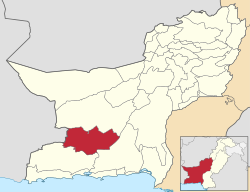District of Balochistan in Pakistan
| Panjgur
ضلع پنجگور پنجگور دمگ | |
|---|---|
| District of Balochistan | |
| Panjgur District | |
 Tomb of Allang Essai, Panjgur Tomb of Allang Essai, Panjgur | |
| Nickname: Gateway to Panjgur | |
 Map of Balochistan with Panjgur District highlighted Map of Balochistan with Panjgur District highlighted | |
| Country | |
| Province | |
| Divisions | Makran |
| Headquarters | Panjgur |
| Government | |
| • Type | District Administration |
| • Deputy Commissioner | Sadaf Baloch |
| • District Police Officer | Muhammad Hanif |
| • District Health Officer | Asma BALOCH |
| Area | |
| • District of Balochistan | 16,891 km (6,522 sq mi) |
| Elevation | 980 m (3,220 ft) |
| Population | |
| • District of Balochistan | 509,781 |
| • Density | 30/km (78/sq mi) |
| • Urban | 157,693 |
| • Rural | 352,088 |
| Time zone | UTC+5 (PST) |
| Postal code | 93000 |
| Dialing code | 0855 |
| Number of Tehsils | 3 |
| Website | panjgur |

Panjgur (Balochi: پنجگور دمگ, Urdu: ضلع پنجگور) is a district in the western part of Balochistan province of Pakistan. Panjgur was one of three tehsils of Makran District until 1 July 1977, when the district became a part of Makran Division. The other two districts of Makran Division are Kech (Turbat) and Gwadar. Chitkan is the district headquarter. Panjgur has sixteen (16) Union Councils.
Panjgur (literally: Five Graves) is home to several archaeological sites, including centuries-old tombs, an old dam called Band-e-Gillar, remnants of a fort at Khudabadan (the historical fort of Nawab Kharan) and some remnants of the old port of Issai. The seasonal Rakshan River flows right in the middle of Panjgur, dividing it into two parts, the northern and southern Panjgur.
Etymology
In Iranian languages, "panj" means "five" and "gor" means "graves". There are five popular graves in this district, which give it the name Panjgur or Panjgor.
Administrative divisions
The district is administratively subdivided into following tehsils which contain a total of 16 Union Councils:
| Tehsil | Area
(km²) |
Pop.
(2023) |
Density
(ppl/km²) (2023) |
Literacy rate
(2023) |
Union Councils |
|---|---|---|---|---|---|
| Gowargo Tehsil | 1,471 | 31,718 | 21.56 | 27.57% | ... |
| Panjgur Tehsil | 2,945 | 392,277 | 133.20 | 46.19% | ... |
| Paroom Tehsil | 3,378 | 31,113 | 9.21 | 38.64% | ... |
| Gichk Tehsil | 8,387 | 33,578 | 4.00 | 20.15% | ... |
| Kallag Tehsil | ... | ... | ... | 38.40% | ... |
Demographics
| Year | Pop. | ±% p.a. |
|---|---|---|
| 1951 | N/A | — |
| 1961 | N/A | — |
| 1972 | N/A | — |
| 1981 | N/A | — |
| 1998 | 234,051 | — |
| 2017 | 315,353 | +1.58% |
| 2023 | 509,781 | +8.33% |
| Sources: | ||
Population
As of the 2023 census, Panjgur district has 117,089 households and a population of 509,781. The district has a sex ratio of 112.09 males to 100 females and a literacy rate of 42.07%: 45.80% for males and 37.80% for females. 155,552 (30.51% of the surveyed population) are under 10 years of age. 157,693 (30.93%) live in urban areas.
Religion
| Religions in Panjgur district (2023) | ||||
|---|---|---|---|---|
| Religion | Percent | |||
| Islam | 99.20% | |||
| Christianity | 0.44% | |||
| Other or not stated | 0.36% | |||
In the 2023 census, 4,079 (0.8%) people in the district were from religious minorities, mainly Christians.
Language
Balochi was the predominant language, spoken by 99.63% of the population.
Transport
Panjgur Airport (IATA: PJG, ICAO: OPPG) is a domestic airport. Its short runway stretches only 1,524 meters. PIA started flights to Sharjah in 2013, but these have been suspended by PIA. People in Panjgur normally travel by buses to bigger cities like Quetta and Karachi.
References
- ^ "Population by Mother Tongue, Sex and Rural/Urban, Census-2023" (PDF). Pakistan Bureau of Statistics.
- ^ "Tehsils & Unions in the District of Panjgur – Government of Pakistan website". Archived from the original on 26 March 2012. Retrieved 16 April 2023.
- "TABLE 1 : AREA, POPULATION BY SEX, SEX RATIO, POPULATION DENSITY, URBAN POPULATION, HOUSEHOLD SIZE AND ANNUAL GROWTH RATE, CENSUS-2023, BALOCHISTAN" (PDF).
- "LITERACY RATE, ENROLMENT AND OUT OF SCHOOL POPULATION BY SEX AND RURAL/URBAN, CENSUS-2023, BALOCHISTAN" (PDF).
- "Population by administrative units 1951-1998" (PDF). Pakistan Bureau of Statistics.
- ^ "7th Population and Housing Census - Detailed Results: Table 1" (PDF). Pakistan Bureau of Statistics.
- "7th Population and Housing Census - Detailed Results: Table 12" (PDF). Pakistan Bureau of Statistics.
- "7th Population and Housing Census: Population by Mother Tongue, Sex and Rural/Urban" (PDF). Pakistan Bureau of Statistics.
- ^ "7th Population and Housing Census - Detailed Results: Table 9" (PDF). Pakistan Bureau of Statistics.
External links
| Districts of Balochistan, Pakistan | ||
|---|---|---|
| Provincial capital: Quetta | ||
| Kalat |  | |
| Makran | ||
| Nasirabad | ||
| Quetta | ||
| Sibi | ||
| Zhob | ||
| Rakhshan | ||
| Loralai | ||
| - formerly part of Quetta Division; - formerly part of Kalat Division; - formerly part of Zhob Division ; - abolished | ||
26°40′N 64°15′E / 26.667°N 64.250°E / 26.667; 64.250
Categories: